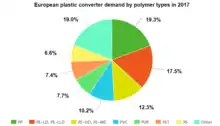Commodity plastics
Commodity plastics are plastics produced in high volumes for applications where exceptional material properties are not needed (such as packaging, food containers, and household products). In contrast to engineering plastics, commodity plastics tend to be inexpensive to produce and exhibit relatively weak mechanical properties. Some examples of commodity plastics are polyethylene, polypropylene, polystyrene, polyvinyl chloride, and poly(methyl methacrylate).[2] Globally, the most widely used thermoplastic includes both Polypropylene and Polyethylene.[3]

Products made from commodity plastics include disposable plates, disposable cups, photographic and magnetic tape, clothing, reusable bags, medical trays, and seeding trays.[4] Several investigation suggests that the kinetics of thermal degradation of commodity plastics is important to realize the complications it may bring because of the temperature that it goes through which includes production process or manufacturing process.[5] Plastic includes high molecular weight and burning them is too risky as it is interacted with mass and energy transport which brings complications if not properly investigated.[6] Despite the complications of plastics, plastic makers recycle for new growth as it introduces with how countries like the United States have limited the use of products made by plastics and it has also been trending in Europe and Japan.[7] The tactics of marketing strategies to recycle plastics can be a huge growth to plastic makers as people tend to purchase the recycled materials more. Companies like Procter & Gamble and Clorox makes the use of recycled products to manufacture household products.[8]
Further reading
- Engineering plastics
- High performance plastics
- Haugan, Harold W. Fantastic Plastics—Welcome Aboard (Exposition Press Books, 1974)
References
- "Plastics - the Facts 2018" (PDF). Retrieved 24 October 2019.
- "Plastics the Facts 2014/2015 at plasticseurope.org". Archived from the original on 10 June 2015. Retrieved 18 June 2015.
- Andrady, Anthony L.; Neal, Mike A. (2009-07-27). "Applications and societal benefits of plastics". Philosophical Transactions of the Royal Society B: Biological Sciences. 364 (1526): 1977–1984. doi:10.1098/rstb.2008.0304. ISSN 0962-8436. PMC 2873019. PMID 19528050.
- Kaiser, Wolfgang (2011). Kunststoffchemie für Ingenieure: Von der Synthese bis zur Anwendung. Carl Hanser. p. 439. ISBN 9783446430471.
- Bockhorn, H.; Hornung, A.; Hornung, U.; Teepe, S.; Weichmann, J. (August 1996). "Investigation of the Kinetics of Thermal Degradation of Commodity Plastics". Combustion Science and Technology. 116–117 (1–6): 129–151. doi:10.1080/00102209608935546. ISSN 0010-2202.
- Bockhorn, H.; Hornung, A.; Hornung, U.; Teepe, S.; Weichmann, J. (August 1996). "Investigation of the Kinetics of Thermal Degradation of Commodity Plastics". Combustion Science and Technology. 116–117 (1–6): 129–151. doi:10.1080/00102209608935546. ISSN 0010-2202.
- O'SULLIVAN, DERMOT (1990-05-21). "German chemical giants join to recycle plastics". Chemical & Engineering News. 68 (21): 8. doi:10.1021/cen-v068n021.p008a. ISSN 0009-2347.
- O'SULLIVAN, DERMOT (1990-05-21). "German chemical giants join to recycle plastics". Chemical & Engineering News. 68 (21): 8. doi:10.1021/cen-v068n021.p008a. ISSN 0009-2347.